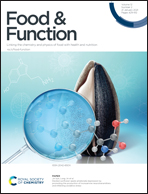The potential neuroprotective role of Amphora coffeaeformis algae against monosodium glutamate-induced neurotoxicity in adult albino rats†
Abstract
Monosodium glutamate (MSG) is a neurotoxin found in most processed and infant formulas. Amphora coffeaeformis (AC) has neuroprotective properties. We investigated, for the first time, the potential neuroprotective role of AC on MSG-induced neurotoxicity in brain using a unique procedural approach. The AC extract was characterized via high performance liquid chromatography (HPLC). Animals were assigned into six groups; a control group, low dose MSG (LD-MSG), high dose MSG (HD-MSG), combined groups (LD-MSG + AC) (HD-MSG + AC) and AC only group for eight weeks. Assessment of the cognitive and mood domains was done via Barnes maze and an open field. Gene expression of Bdnf, TrkB, NMDA-B2 and mGlur5 in the hippocampus was obtained via real-time PCR. The hippocampi of the animals were assessed for structural changes. Oxidative stress was assessed in the cerebrum. The results revealed that omega-6 and β-coumaric acid represented the highest percentage among the constituents in the AC extract. The NO level was decreased in the LD-MSG + AC compared to LD-MSG. SOD was diminished in both treated groups compared to the untreated group. HD-MSG + AC exhibited an increase in the number of wrongly visited quadrants compared to the HD-MSG group. HD-MSG + AC showed decreased anxiety-like behavior compared to HD-MSG. LD-MSG + AC and AC groups revealed enhanced anxiety-like behavior. HD-MSG + AC showed under expressed NMDA-B2 and over expressed Bdnf and TrkB genes, compared to HD-MSG. LD-MSG + AC revealed under expression of Bdnf gene compared to LD-MSG. The AC group revealed under expressed TrkB gene compared to the control group. Overall, the results refer to the potential neuroprotective properties of AC alga against MSG neurotoxicity.



 Please wait while we load your content...
Please wait while we load your content...